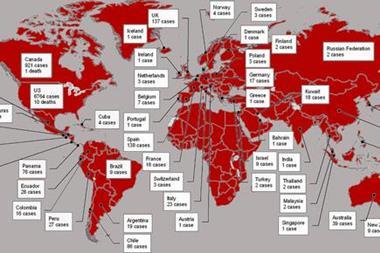Extractive industries’ responsibilities
Extractive industries, such as mining or oil, often have to dig for their wealth in resource-rich, low-income countries. Success here relies on engaging with the local community, behaving responsibly and being sustainable as far as that is possible. This is not always easy.
Even in the face of recession, a steepening demand for energy and natural resources has led many poor but resource-rich countries to open their borders to foreign investment. Many of these countries where natural resources – such as precious metals and minerals – are found lack strong institutions and governance frameworks. For this reason, it is hard for them to prevent foreign companies from exploiting them.
The oil, gas and mining sector has a history of harmful environmental and social impacts. Royal Dutch Shell has been in the headlines recently for alleged human rights abuses in Nigeria. Shell was found guilty of complicity in the 10 November 1995 execution of Nigerian activist Ken
Saro-Wiwa and other environmental leaders opposed to Shell’s operations in the Niger Delta. Shell was accused of involvement in torture, illegal detainment and crimes against humanity. And the company could be forced to pay hundreds of millions of dollars worth of damages.
As well as causing serious distress and harm to communities these incidents pose risks to governments, companies and their financiers. To combat these risks, various initiatives seek to provide guidance for the extractors to follow. Some financiers even require their customers to meet these environmental and social standards. Mining and energy companies should be aware of what is expected of them from shareholders, governments and the general public to avoid the financial and reputational impact of being associated with environmental damage, social disruption or human rights violations.
The leaders of most responsible mining and oil extraction projects recognise this and they realise that a strong relationship with those affected by a project improves the chances of its long-term success. The local community can grant a company its licence to operate. Working in a hostile environment is no fun for anyone.
“Rio Tinto and DeBeers, for example, have negotiated agreements with communities on how to avoid harm,” said Jonathan Lash, president, World Resources Institute (WRI). “In so doing, they have gained strong local support for projects, while communities have seized opportunities for development.”
Even so, according to a new report from the WRI, community engagement efforts by the extractive industries are falling short because of a failure to understand local political and community dynamics. For this reason the WRI has developed seven principles for effective community engagement.
Extractive and infrastructure projects both affect and are affected by the environments in which they operate.
“Community engagement can benefit everyone involved, contributing to reduced costs and risks for project proponents while enhancing access to new opportunities for host communities,” added Lash.
Properly engaging with the local community and getting them onside is therefore a vital part of project risk management.
Health and safety at work
A recent Court of Appeal decision on industrial deafness has major implications for Employers Liability, according to a lawyer close to the case.
The case refers to a February 2007 decision by the Nottingham High Court to dismiss claims by seven former textile workers that they had suffered noise induced hearing loss after working in factories.
One of the claimants decided to appeal that decision. She claimed that her employer was in breach of its duty to provide a safe workplace. On 22 May, the Court of Appeal delivered its judgment on this high profile case, Baker v Quantum Clothing.
The case hinged on the legal definition of ‘safe’. Put simply the Court of Appeal decided that noise levels in the textile factory represented a risk to workers, which meant the employer should have taken action to remove the noise.
In the lower court the employer relied on the defence of reasonably foreseeability, that is they could not reasonably be expected to know that the noise levels represented a health risk.
But Lady Justice Smith decided that safety was a purely objective matter to which foresight of risk was irrelevant. She said that from the introduction of a safety code of practice in the 1970s employers should have understood what represented unsafe noise levels and it was up to the employer to show that it had done all that was reasonably practicable to keep the workplace safe.
Cameron Clark, a partner at Halliwells, who has been closely involved in the case, said this judgment has considerable consequences to employers facing industrial deafness claims as well as all future employers’ liability claims.
He commented: “Although this decision involved an industrial deafness claim, it has wider policy implications spanning across all employers’ liability claims.
“It imposes a strict duty under statute upon employers even though Health and Safety Executive guidance and the general appreciation within the industry at the time as to what was considered safe was then different.”
Clark continued: “The judge applied the advantage of hindsight to employers’ duties – making it much more difficult to defend these types of claims.
“This decision now extends beyond the issue of noise induced hearing loss,” he added. “Every person with an employers liability claim will be able to rely upon this decision until, and unless, it is overturned.
“Claimants will look to take advantage of this pro-claimant interpretation of employers’ duties. They will be able to use the new definition of what ‘safe’ means as a weapon in their armoury against employers and their insurers.”
The case is expected to be appealed in the House of Lords in mid 2010.
“We will be seeking to restate what was originally held in the Nottingham High Court,” explained Clark, who has been asked to take the matter to the House of Lords.
Dutch risk manager survey
The opinions of Dutch risk and insurance professionals were canvassed at a recent conference in the Netherlands.
Over 200 delegates, including about 75 risk managers, gave their verdict on current risk issues and the financial crisis. Attendees at the Nederlandse Associatie van Risk en Insurance Managers (NARIM) annual conference were asked to respond “yes” or “no” to a number of motions.
The delegates were asked: “When receiving tenders, insurance managers look more at price rather than at the contents/cover.”
Over 80% of the risk managers disagreed with this. In a notable result, which revealed a significant lack of understanding in the market, over half of the brokers (about 50%), insurers (about 70%) and claims experts (about 60%) agreed with this statement.
The result suggests that the sellers of insurance should remember that low-cost policies are not always what risk managers are looking for.
Participants were more or less evenly split over the next assertion, which said that “the absence of different supervisory rules for captives and other types of insurer will result in a decrease in the number of Dutch captives”.
Hardly anyone agreed, however, that the introduction of Solvency II would avoid another credit crunch.
With the exception of some claims experts (about 40%) and a few risk managers (about 20%), the participants were optimistic that the credit crisis would not prevent a quick recovery. But very few people (under 20% in each job category) agreed that under a single European supervisory system the credit crisis would have been limited.
On the question of market pricing and coverage the results were more mixed. The motion was: “The market will not harden until a world wide catastrophe occurs.”
Brokers were split down the middle, half of them agreed and half of them disagreed. Insurers and risk managers were slightly more disapproving of this statement. Just less than 60% disagreed with it, while the vast majority (over 80%) of the claims experts disagreed.
The next assertion put before the NARIM congress was: “The value of the judgment of the rating agencies is over rated.” Here the results spoke for themselves. More or less everyone agreed.
Most NARIM members (60%) agreed that “risk management paragraphs in annual reports do not say anything about operational risk management”. The other professions were also largely in agreement.
On a positive note, most people (around 75% overall) agreed that “the economic crisis/credit crunch would lead to better risk management”.
Hosted by comedian and actor Tom Allen, 34 Gold, 23 Silver and 22 Bronze awards were handed out across an amazing 34 categories recognising brilliance and innovation right across the breadth of UK general insurance.













































No comments yet